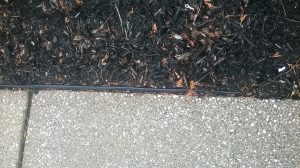
Landscape edging can do wonderful things for your landscape. Its main purpose is to separate two different materials. However, there are times when landscape edging does not get used properly. This is unneeded landscape edging.
Landscape edging is typically used to separate two soft materials. Soft materials would be items that can move around with the forces of nature, or through use, or through gravity. Some examples of soft materials that are moveable are grass, mulch, stones, sand, etc.
It is unnecessary to use edging where a soft material meets a hard surface. Some examples of hard surfaces are concrete, asphalt, houses, etc. When using a landscape edging next to a hard material, it is just a waste. The hard material like concrete will do the holding back.
Sometimes materials like bark will spill over onto the concrete for example. This is not a edging problem, this is a grading problem or a too much material problem. This can be fixed by changing the grade or removing some of the excess bark. Adding edging that is raised up will stop the overflow, but it looks goofy and is putting only a band aide on the problem.
Simply put, adding edging along a hard surface is a waste. It typically stands out like a sore thumb, and it does not do anything that the hard surface cannot do.